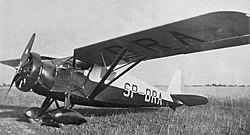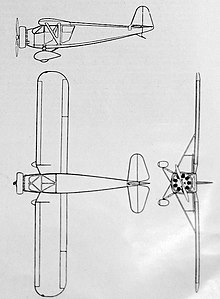RWD-9
| RWD-9 | |
|---|---|
 RWD-9 with Walter Bora engine |
|
| Type: | Sports and touring aircraft |
| Design country: | |
| Manufacturer: | |
| First flight: |
4th December 1933 |
| Commissioning: |
1934 |
| Number of pieces: |
8th |
The Polish RWD-9 is a light civil aircraft of the 1930s. The abbreviation RWD stands for the design team Rogalski, Wigura and Drzewiecki.
development

The RWD-9 was designed in 1933 for participation in the European tour of 1934 and as a successor to the RWD-6 , which won 1st place at the event last year . However, it turned out that the construction of the wing was too weak, which is why one of the three built examples had an accident during the first test flights due to a broken wing. Almost a month after the competition, on September 11, 1932, a second RWD-6 crashed on the way from Warsaw to Prague, also after breaking the wing, tragically killing the victorious pilot Franciszek Ż Wirko and the member of the RWD construction group Stanisław Wigura came. The construction of the RWD-9, which was co-financed by the event organizers and a memorial committee for the two aircraft involved in the accident, therefore concentrated on strengthening the structure, which was also equipped with slats , slotted flaps and spoilers in accordance with the competition requirements to improve the short take-off properties . In order to achieve a high score in the technical assessment, the wing was designed to be foldable on the side of the fuselage. In addition to these aspects, the RWD-9 differed from its predecessor mainly in the increase in the number of seats from two to four. Originally the new Škoda GR-760 from Czech production was to be used as the drive ; However, since there were delays in its development, the prototype was initially equipped with a B-6S Buccaneer with 198 kW (269 hp) and the Škoda engine was retrofitted later. In addition, an airframe was made for static tests . The flight tests began on December 4, 1933 and was successfully completed. A total of eight copies were made of the RWD-9, equipped in equal parts with either the GR-760 or the also Czech Walter Bora with 162 kW (220 PS) and, depending on their engine, as RWD-9S (for Škoda) or RWD-9W (for Walter ) were designated.
Participation in the European tour was a great success for the RWD-9. Four out of six participating pilots came in the final ranking with their aircraft among the top ten; Jerzy Bajan and Stanisław Płonczyński took first and second place respectively. The RWD-9 was also victorious in the technical competition and took first to third place.
At the end of 1938, the prototype of the RWD-9 was equipped with a rigid nose wheel landing gear for test purposes and tested with an in-line engine Walter Major (97 kW (132 PS)) under the designation RWD-20 .
Military users
-
 Spain
Spain
- Spanish Republican Air Force
-
 Spain
Spain
- Spanish Air Force - after the Civil War
Technical specifications
| Parameter | Data |
|---|---|
| crew | 2 |
| Passengers | 2 |
| length | 7.60 m |
| span | 11.64 m |
| height | 2.03 m |
| Wing area | 16.00 m² |
| Wing extension | 8.5 |
| payload | 370 kg |
| Empty mass | 560 kg |
| Max. Takeoff mass | 790 kg |
| Cruising speed | 255 km / h |
| Top speed | 281 km / h near the ground |
| Service ceiling | 7000 m |
| Range | 800 km |
| Engines | an air-cooled radial engine Škoda GR-760 with 213 kW (290 PS) |
literature
- Václav Němeček: Airplanes . Civil aircraft from the years 1903–1957. Dausien, Hanau 1991, ISBN 3-7684-0125-1 , p. 154/155 .
- Peter All-Fernandez (ed.): Aircraft from A to Z . Aamsa Quail-Consolidated P2Y. tape I . Bernard & Graefe, Koblenz 1987, ISBN 3-7637-5904-2 , p. 255/256 .

